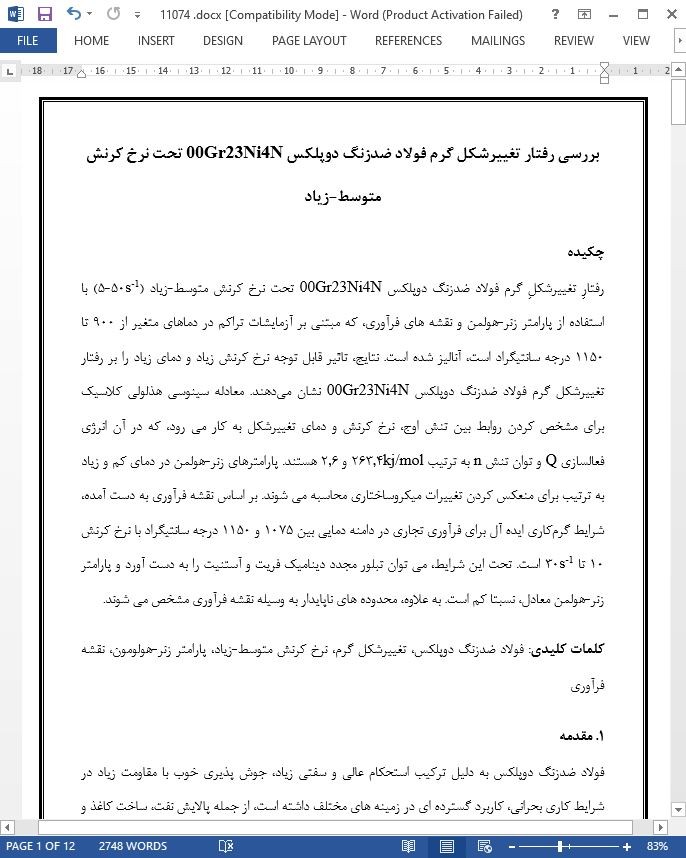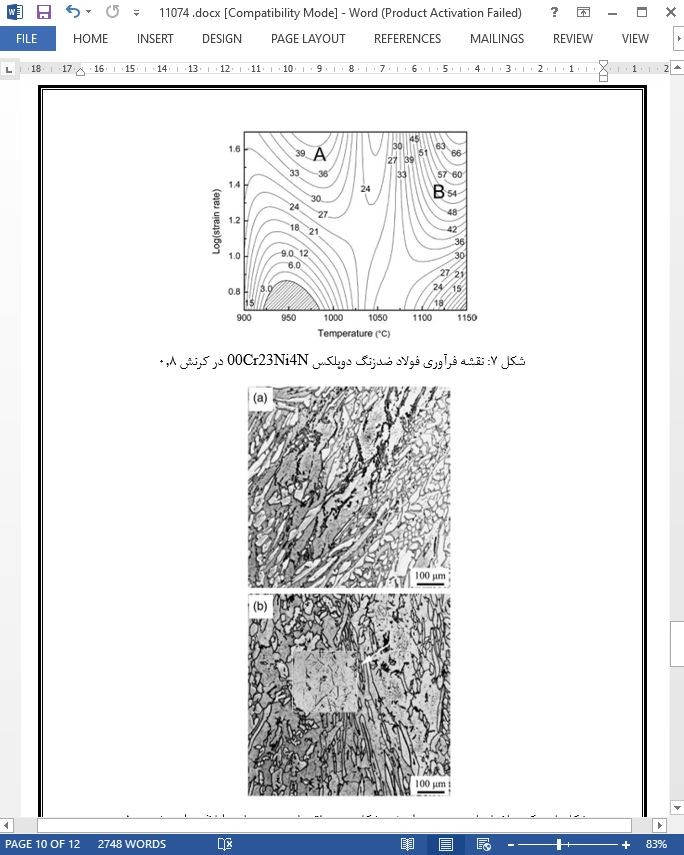
بررسی رفتار تغییرشکل گرم فولاد ضدزنگ دوپلکس 00Gr23Ni4N تحت نرخ کرنش متوسط-زیاد
چکیده
رفتارِ تغییرشکلِ گرم فولاد ضدزنگ دوپلکس 00Gr23Ni4N تحت نرخ کرنش متوسط-زیاد (s-150-5) با استفاده از پارامتر زنر-هولمن و نقشه های فرآوری، که مبتنی بر آزمایشات تراکم در دماهای متغیر از 900 تا 1150 درجه سانتیگراد است، آنالیز شده است. نتایج، تاثیر قابل توجه نرخ کرنش زیاد و دمای زیاد را بر رفتار تغییرشکل گرم فولاد ضدزنگ دوپلکس 00Gr23Ni4N نشان می دهند. معادله سینوسی هذلولی کلاسیک برای مشخص کردن روابط بین تنش اوج، نرخ کرنش و دمای تغییرشکل به کار می رود، که در آن انرژی فعالسازی Q و توان تنش n به ترتیب kj/mol263.4 و 2.6 هستند. پارامترهای زنر-هولمن در دمای کم و زیاد به ترتیب برای منعکس کردن تغییرات میکروساختاری محاسبه می شوند. بر اساس نقشه فرآوری به دست آمده، شرایط گرم کاری ایده آل برای فرآوری تجاری در دامنه دمایی بین 1075 و 1150 درجه سانتیگراد با نرخ کرنش 10 تا s-130 است. تحت این شرایط، می توان تبلور مجدد دینامیک فریت و آستنیت را به دست آورد و پارامتر زنر-هولمن معادل، نسبتا کم است. به علاوه، محدوده های ناپایدار به وسیله نقشه فرآوری مشخص می شوند.
1. مقدمه
فولاد ضدزنگ دوپلکس به دلیل ترکیب استحکام عالی و سفتی زیاد، جوش پذیری خوب با مقاومت زیاد در شرایط کاری بحرانی، کاربرد گسترده ای در زمینه های مختلف داشته است، از جمله پالایش نفت، ساخت کاغذ و صنایع اقیانوسی. این ویژگی های خوب فولاد ضدزنگ دوپلکس وابسته به میکروساختار دو مرحله ای است که از مقدار تقریبا برابر آستنیت و فریت تشکیل می شود. بنابراین، عملکرد عالی و میکروساختار خاص، فولاد ضدزنگ دوپلکس را به گروهی خاص در همه فولادهای ضدزنگ تبدیل کرده است.
4. نتیجه گیری
رفتار تغییرشکل گرم فولاد ضدزنگ دوپلکس 00Cr23Ni4N تحت نرخ های کرنش متوسط-زیاد در تراکم در دماهای 900 تا 1150 درجه سانتیگراد مطالعه شد. این نتایج به دست آمدند:
1) می توان معادله سینوسی هذلولی کلاسیک را برای توصیف رابطه بین تنش اوج، نرخ کرنش و دمای تغییرشکل به کار برد که در آن میانگین انرژی فعالسازی Q و n به ترتیب kJ/mol263.4 و 2.6 هستند.
2) هرچه پارامتر Z کمتر باشد، تنش جریان کمتر است، انرژی فعالسازی کمتر است و بنابراین تبلور مجدد دینامیک راحت تر اتفاق می افتد.
Abstract
The hot deformation behavior of 00Cr23Ni4N duplex stainless steel under medium–high strain rates (5–50 s− 1) has been analyzed using the Zener–Hollomon parameter and processing maps, which is based on compression tests made at temperatures ranging from 900 to 1150 °C. The results display the significant influence of high strain rate and high temperature on hot deformation behavior of 00Cr23Ni4N duplex stainless steel. A classical hyperbolic sine equation is applied to reveal the relations between the peak stress, strain rate and deformation temperature, in which the activation energy, Q and stress exponent, n are 263.4 kJ/mol and 2.6, respectively. The Zener–Hollomon parameters at low and high temperatures are calculated respectively to reflect the microstructural evolutions. Based on the processing map obtained, an ideal hot working condition for commercial processing is in the temperature range between 1075 and 1150 °C with a strain rate of 10 to 30 s− 1. Under such condition, both ferrite and austenite dynamic re-crystallizations can be obtained and the corresponding Zener–Hollomon parameter is relatively low. Furthermore, the unstable domains are indicated by the processing map.
1. Introduction
Due to the excellent combination of high strength and toughness, good weldability with superior resistance under critical working conditions, duplex stainless steel has been widely used in diverse fields, such as petroleum refining, paper manufacturing and ocean industries etc. [1–3]. Such good properties of duplex stainless steel rely on a two-phase microstructure comprised by approximately equal amounts of austenite and ferrite [4]. Therefore, the high performance and special microstructures have made duplex stainless steel a special class in all stainless steels.
4. Conclusions
The hot deformation behavior of 00Cr23Ni4N duplex stainless steel under medium–high strain rates is studied in compression at temperatures from 900 to 1150 °C. Below is the results obtained:
(1) The classical hyperbolic sine equation can be adopted to describe the relationship among the peak stress, strain rate and deformation temperature, in which the mean activation energy, Q and n are 263.4 kJ/mol and 2.6 respectively.
(2) The lower the Z parameter, the lower the flow stress, the lower the activation energy and the more easily the dynamic re-crystallization may occur.
چکیده
1. مقدمه
2. مواد و روش ها
3. نتایج و بحث
3.1 تنش های جریان
3.2 مشخصات انرژی فعالسازی و پارامتر Z
3.3 نقشه فرآوری و میکروساختار
4. نتیجه گیری
ABSTRACT
1. Introduction
2. Materials and Methods
3. Results and Discussion
3.1. Flow Stress
3.2. Characterizations of Activation Energy and Z Parameter
3.3. Processing Map and Microstructure
4. Conclusions
- اصل مقاله انگلیسی با فرمت ورد (word) با قابلیت ویرایش
- ترجمه فارسی مقاله با فرمت ورد (word) با قابلیت ویرایش، بدون آرم سایت ای ترجمه
- ترجمه فارسی مقاله با فرمت pdf، بدون آرم سایت ای ترجمه



